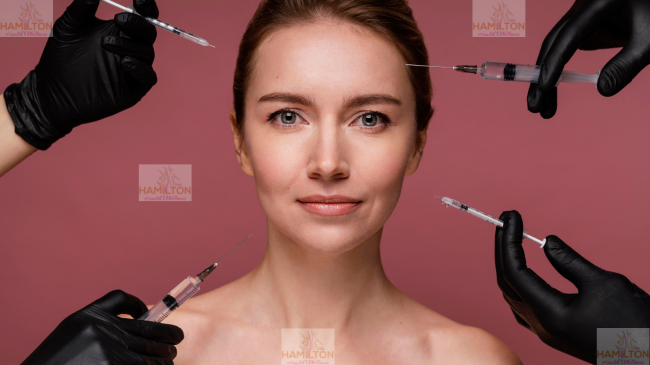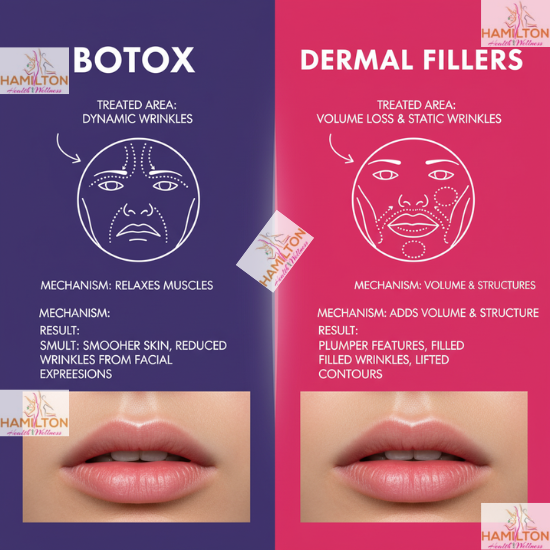Botox and dermal fillers are the most popular treatments, making them the hallmark of aesthetic medicine. Their widespread recognition is credited to their ability to restore a youthful appearance.
Most people combine the two solutions for natural contouring and softening visible signs of aging. Botox smooths out wrinkles and age lines, whereas dermal fillers restore lost volume and define facial features.
Even though the two are most often mentioned together for reducing wrinkles and facial lines, they differ in the purposes they serve and their mechanisms. At the end of this article, the readers will gain insights into the distinctions between Botox and dermal fillers.

What to Know About Botox?
Botox is a purified neurotoxic protein originating from the Clostridium botulinum bacterium. This natural compound is injected in small, controlled amounts to reduce wrinkles and facial lines.
The mechanism temporarily blocks nerve signals to specific muscles, causing them to contract and ultimately relax.
Cosmetically, Botox targets areas most prone to skin folds and expression lines. Such aging elements usually develop from frowning, squinting, or smiling. The areas include:
- Forehead
- Between the eyebrows
- Around the eyes
- Nose
- Neck
- Chin
Medically, the treatment can improve the conditions of chronic migraines, excessive perspiration, muscle spasms, and eye disorders.

How to Define Dermal Fillers?
Dermal fillers are gel-like substances that, when injected, either restore or replace the volume of the skin. Additionally, they are used for facial contouring, a technique that refines or reshapes the natural structure of the face to make it look more sculpted.
The targeted zones include:
- Cheeks and temples
- Smile lines
- Vertical line defining the mouth-to-chin area
- Lips
- Under-eyes
- Jawline and chin
The most common and naturally occurring filler ingredient is hyaluronic acid. However, dermal fillers can be made up of:
- Calcium Hydroxyapatite
- Poly-L-lactic acid
- Polymethylmethacrylate

What Makes Botox and Dermal Fillers Different?
Purpose
Botox primarily targets movement-related wrinkles resulting from muscle activity. Dermal fillers, on the other hand, focus on adding volume to plump up and smooth out age-related changes. It also offers contouring to enhance the facial features for a balanced appearance.
Visibility
It takes approximately two weeks for the full results of Botox to be noticeable. However, the person can make out variations within a week. The results of fillers are seen immediately after treatment.
Duration
Botox is effective for four months, after which the muscles gradually return to their original activity. Depending on the type of filler, the treatment remains effective for six months to two years.
Mechanism
The process of Botox includes muscle relaxation, while dermal fillers depend on volume restoration.
Reversibility
The treatment outcomes of Botox dissolve naturally over time, but this is not the case with fillers. An enzyme called hyaluronidase is used to adjust or entirely break down the effects of hyaluronic acid gel.
Ideality
Botox is the best for reducing wrinkles and facial lines. Whereas, for adding volume and contouring, dermal fillers are the go-to option.
How to Decide the Suitability of Treatment?
Many people combine Botox and dermal fillers for a youthful look. However, it is important to first understand the suitability of both treatments before making any decision.
Identify the Priorities
The individual must have a clear goal path. For different objectives, several treatment options are available.
For instance, if the debate is wrinkles vs. loss of volume, the practitioner will suggest both treatments for types of wrinkles. But he will only consider fillers for adding volume.
Assess Facial Features
Another important aspect is determining the area that needs treatment. A qualified practitioner will evaluate bone structure, muscle activity, and skin elasticity. These factors also identify whether the treatment will be beneficial.
Medical History
The patient’s health conditions, allergies, and ongoing medications, if any, are also taken into account.
Conclusion
Hence, both Botox and dermal fillers serve a similar purpose of skin rejuvenation. They are a non-invasive procedure with minimal downtime and discomfort. This in-house treatment can be customized and is a proven method that boosts self-confidence.
Hamilton Health Wellness is a dedicated healthcare center that specializes in aesthetic medicine. They offer advanced, science-based treatments that enhance a person’s natural beauty while complementing internal health.
Frequently Asked Questions | Botox and Dermal Fillers?
Which lasts longer: Botox or fillers?
Dermal fillers generally last longer.
Can both treatments be done together?
Yes, both can be safely combined.
Are there any side effects?
Redness, swelling, bruising, and tenderness are common reactions.
How often should I get these treatments?
The maintenance plan depends on the person’s goals, skin condition, and body metabolism.







